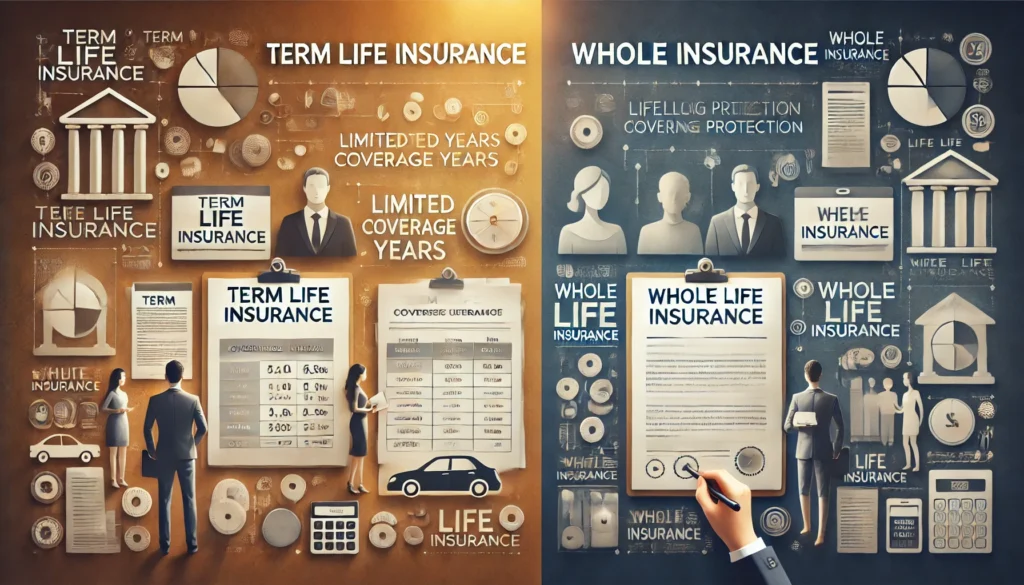Introduction
Life insurance is a crucial part of financial planning, providing security for loved ones in the event of your death. However, choosing the right type of life insurance can be challenging. Among the various options available, term life insurance and whole life insurance are two of the most common. Each has distinct features, benefits, and drawbacks.
This article aims to provide an in-depth comparison of term and whole life insurance, helping you make an informed decision about which type is right for you. We will explore the definitions, benefits, drawbacks, costs, and factors to consider for both types of insurance. By the end, you will have a clear understanding of how these options differ and which may be the best fit for your needs.
1. Understanding Life Insurance Basics
Before diving into the specifics of term and whole life insurance, it’s essential to grasp the basic concepts of life insurance.
1.1. What is Life Insurance?
Life insurance is a contract between you (the policyholder) and an insurance company. In exchange for regular premium payments, the insurer pays a designated amount (the death benefit) to your beneficiaries upon your death. This financial protection helps cover various expenses, including funeral costs, debts, and living expenses.
1.2. Key Terms to Know
To understand life insurance better, familiarize yourself with some key terms:
- Premium: The amount you pay for your policy, typically on a monthly or annual basis.
- Death Benefit: The sum of money paid to your beneficiaries upon your death.
- Beneficiary: The person(s) or entity designated to receive the death benefit.
- Policy: The legal contract outlining the terms of your coverage.
- Rider: An optional add-on that provides additional benefits or coverage.
2. Term Life Insurance
Term life insurance is designed to provide coverage for a specified period, typically ranging from 10 to 30 years. If you pass away during the term, your beneficiaries receive the death benefit. If you outlive the term, the policy expires, and there is no payout.
2.1. Features of Term Life Insurance
2.1.1. Coverage Duration
Term life insurance offers coverage for a set number of years. Common term lengths include 10, 15, 20, and 30 years. This makes it a suitable option for those seeking temporary coverage during critical financial periods.
2.1.2. Simplicity
Term policies are straightforward and easy to understand, making them accessible for first-time buyers. You pay a premium for a specified term in exchange for a death benefit.
2.1.3. No Cash Value
Term life insurance does not accumulate cash value. If you outlive the policy, there is no payout, and you do not receive any benefits other than the death benefit.
2.2. Benefits of Term Life Insurance
2.2.1. Affordability
One of the most significant advantages of term life insurance is its affordability. Premiums for term policies are generally lower than those for whole life insurance, making it accessible for a broader range of individuals.
2.2.2. Flexibility
Term life insurance allows you to choose the length of coverage that fits your needs. For example, you might opt for a 20-year term to coincide with your mortgage or until your children are financially independent.
2.2.3. Convertibility
Many term life policies offer a conversion option, allowing you to convert your term policy into a permanent policy without undergoing a new medical exam. This can be beneficial if your health changes or you want lifelong coverage later.
2.3. Drawbacks of Term Life Insurance
2.3.1. No Lifelong Coverage
Term life insurance provides coverage only for a specified period. If you outlive the term, you may need to purchase a new policy at a potentially higher premium based on your age or health.
2.3.2. No Cash Value Accumulation
Unlike whole life insurance, term policies do not build cash value. If you cancel the policy or let it expire, you do not receive any money back.
2.3.3. Renewable Premiums
While some term policies can be renewed at the end of the term, the premiums may increase significantly, especially if you have developed health issues.
3. Whole Life Insurance
Whole life insurance, a type of permanent life insurance, provides coverage for your entire lifetime as long as premiums are paid. It also accumulates cash value over time, which can be borrowed against or withdrawn.
3.1. Features of Whole Life Insurance
3.1.1. Lifetime Coverage
Whole life insurance guarantees coverage for your entire life, ensuring that your beneficiaries receive a death benefit no matter when you pass away, as long as premiums are paid.
3.1.2. Cash Value Accumulation
A portion of your premium goes into a cash value account, which grows over time at a guaranteed rate. This cash value can be accessed through loans or withdrawals.
3.1.3. Fixed Premiums
Premiums for whole life insurance are typically fixed, meaning they won’t increase as you age. This predictability can aid in long-term financial planning.
3.2. Benefits of Whole Life Insurance
3.2.1. Lifelong Protection
Whole life insurance offers lifelong coverage, making it an excellent option for those who want to ensure their loved ones are financially protected no matter when they pass away.
3.2.2. Cash Value Growth
The cash value component can serve as a savings mechanism, providing a source of funds that can be accessed during your lifetime. This can be beneficial in emergencies or for significant expenses, such as college tuition.
3.2.3. Estate Planning Benefits
Whole life insurance can play a vital role in estate planning by providing liquidity to cover estate taxes and ensuring your heirs receive a financial legacy.
3.3. Drawbacks of Whole Life Insurance
3.3.1. Higher Premiums
Whole life insurance generally has higher premiums compared to term policies. This can make it less affordable for some individuals, especially when starting their families or careers.
3.3.2. Complexity
Understanding the mechanics of whole life insurance, including how cash value accumulates and how it can be accessed, can be complex. This may require additional research or consultation with a financial advisor.
3.3.3. Limited Investment Choices
While whole life policies provide a guaranteed cash value growth, the growth rate is often lower compared to other investment options. Those seeking high returns may find better opportunities elsewhere.
4. Cost Comparison: Term vs. Whole Life Insurance
When deciding between term and whole life insurance, understanding the cost implications is essential.
4.1. Premium Differences
4.1.1. Term Life Insurance Premiums
Term life insurance premiums are typically lower than whole life premiums, especially for younger applicants. For example, a healthy 30-year-old might pay a monthly premium of $20 to $50 for a $500,000 term policy.
4.1.2. Whole Life Insurance Premiums
Whole life insurance premiums can be significantly higher, often ranging from $300 to $1,000 per month for the same coverage amount. The higher premiums reflect the lifelong coverage and cash value accumulation.
4.2. Long-Term Costs
Over the long term, the cost of whole life insurance can be substantially higher than term life insurance. If you outlive a term policy and do not renew, you may pay less overall compared to maintaining a whole life policy.
4.3. Value for Money
When evaluating the cost, consider what you are getting for your money. Term life insurance offers pure protection at a lower cost, while whole life insurance provides lifelong coverage and cash value growth, which may be more valuable depending on your financial goals.
5. Choosing the Right Policy for You
Deciding between term and whole life insurance depends on your individual needs and circumstances. Here are some factors to consider:
5.1. Financial Goals
Determine your financial objectives and what you want to achieve with life insurance. If you’re primarily looking for a safety net for a specific period, term life may be suitable. If you want lifelong protection and savings, whole life might be better.
5.2. Budget
Consider your budget for premiums. If affordability is a priority, term life insurance generally offers lower premiums, making it accessible. However, if you can afford the higher cost, whole life insurance provides added benefits.
5.3. Family Situation
Evaluate your family situation and potential future needs. If you have dependents relying on your income, term life insurance can provide adequate protection during their formative years. If you want to leave a legacy for your heirs, whole life insurance may be more appropriate.
5.4. Health Considerations
Your health can impact your insurance choices. If you have health concerns, obtaining a term policy may be easier and more affordable than securing a whole life policy later when your health could deteriorate.
5.5. Long-Term Financial Planning
Consider how life insurance fits into your long-term financial plan. Whole life insurance can serve as a valuable asset in your overall financial strategy, while term life insurance may be more suitable for short-term needs.
6. Frequently Asked Questions (FAQs)
6.1. Can I Convert a Term Policy to Whole Life?
Many term life insurance policies offer a conversion option that allows you to convert your term policy into a whole life policy without a medical exam. This can be beneficial if your health declines during the term.
6.2. What Happens If I Miss a Premium Payment?
If you miss a premium payment on a term policy, you may enter a grace period where you can still make the payment without losing coverage. If you miss a payment on a whole life policy, the insurer may deduct the premium from your cash value or allow a grace period, but you risk losing coverage if payments are not resumed.
6.3. Can I Borrow Against My Policy?
You can borrow against the cash value of a whole life insurance policy, but this is not an option with term life insurance. Borrowing against your policy reduces the death benefit if the loan is not repaid.
6.4. Is Life Insurance Premium Tax-Deductible?
Generally, life insurance premiums are not tax-deductible. However, the death benefit paid to your beneficiaries is typically tax-free, providing them with the full amount without tax implications.
6.5. Can I Change My Beneficiary?
Yes, you can change your beneficiary at any time for both term and whole life policies. This usually requires submitting a form to your insurance provider.
7. Conclusion
Choosing between term and whole life insurance is a significant financial decision that requires careful consideration. Each option has its own set of benefits, drawbacks, and costs, making it essential to evaluate your individual needs, goals, and circumstances.
Term life insurance is an excellent choice for those seeking affordable, temporary coverage during critical financial periods. It provides pure protection without the complexities of cash value accumulation. On the other hand, whole life insurance offers lifelong coverage and the opportunity to accumulate cash value, making it a valuable asset for long-term financial planning.
Ultimately, the best choice depends on your unique situation. By understanding the differences and evaluating your financial goals, you can make an informed decision that provides the security and peace of mind you and your loved ones deserve.





